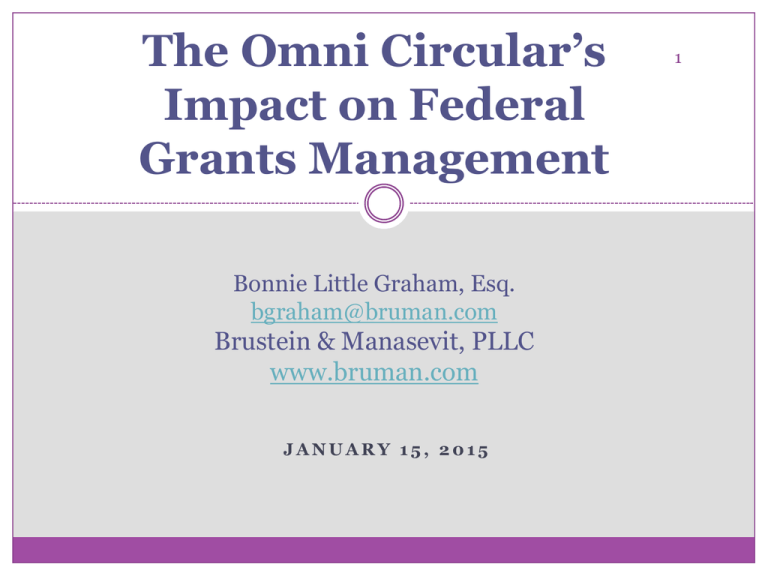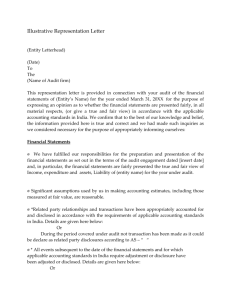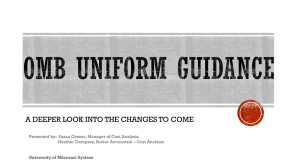Omni Circular's Impact on Federal Grants Management
advertisement

The Omni Circular’s Impact on Federal Grants Management Bonnie Little Graham, Esq. bgraham@bruman.com Brustein & Manasevit, PLLC www.bruman.com JANUARY 15, 2015 1 Agenda 2 Background on Uniform Grants Guidance Grants Management Systems Financial Management, Procurement, Inventory Subrecipient Monitoring Allowability Basic Cost Principles Audits OMB Revised Administrative, Cost, Audit Rules Governing All Federal Grants THE SUPER CIRCULAR – “OMNI CIRCULAR” THE ONE-STOP SHOP FOR FEDERAL ASSISTANCE Key Dates: 4 Feb 1, 2013 Dec 26, 2013 May 2014 June 26, 2014 Dec 26, 2014 NPRM Federal Register New OMB Compliance Supplement ED Draft EDGAR Changes Due Final EDGAR Published What is covered? 5 A-102 – Administrative Rules State / Local – Part 80 – EDGAR A-110 – Administrative Rules Postsecondary – Part 74 – EDGAR A-87 – Cost Rules – State / Local A-21 – Cost Rules – Rules – Postsecondary A-122 – Cost Rules – Nonprofit A-133 – Audit Rules (>$750,000) Who is covered? 6 All “nonfederal entities” expending federal awards 200.69 Date of Applicability of Revised Rules 7 COFAR FAQs: New awards and incremental funding after 12/26/14 Applications for awards made after 12/26/14 should be developed in accordance with Omni Circular Indirect cost rates will be developed in accordance with Omni Circular when due to be re-negotiated One year grace period for procurement for IHEs Federal agencies may apply Omni Circular to unobligated funds as of the Federal award date of the first incremental funding received after 12/26/14 Reasons for the Change? 8 1. Simplicity 2. Consistency 3. Obama Executive Order on Regulatory Review Increase Efficiency Strengthen Oversight Who crafted the changes? 9 Council on Financial Assistance Reform (“COFAR”), and Key Stakeholders www.cfo.gov/cofar Inconsistency Between Program Statute and Circular 10 If federal program statute or regulation differs from Omni Circular, then statute / regulation governs. The Major Themes Impacting Federal Grants Management 11 1. FOCUS ON OUTCOMES 2. PERFORMANCE METRICS 3. RISK ASSESSMENTS 4. FINANCIAL MANAGEMENT POLICIES 5. EQUIPMENT USE 6. MICRO PURCHASES 7. CORRECTIVE ACTION 8. FAMILY FRIENDLY POLICIES 9. FALSE CLAIMS CERTIFICATIONS 10.AUDIT THRESHOLDS Most Significant Change 12 Shift from focus on Compliance to focus on PERFORMANCE!!! Auditors (A-133 + Federal OIG) and Monitors (Federal and State Pass Through) must look more to “outcomes” than to “process” The Omni Circular adds significant flexibility to way grantees / subgrantees can adopt their own processes Most Significant Changes (cont.) The Omni Circular has a MAJOR emphasis on “strengthening accountability” by improving policies that protect against waste, fraud and abuse 13 Structure of Omni-Circular (p. 78608) 14 2 CFR PART 200 (p. 78608) 15 Subpart A – Definitions Subpart B – General Provisions Subpart C – Pre Award Requirements Subpart D – Post Award Requirements Subpart E – Cost Principles Subpart F – Audit Requirements Key Definitions 16 Cognizant Agency for Audit 200.18 (78611) Cognizant Agency for Indirect Costs 200.19 (78611) Computing Devices 200.20 (78612) Cooperative Audit Resolution 200.25 (78612) Cost Objective 200.28 (78612) 17 Internal Control Over Compliance 200.52 (78615) Major Program 200.65 (78615) Micro Purchase 200.67 (78615) Modified Total Direct Cost 200.68 (78615) Non-Federal Entity 200.69 (78615) 18 Conflict of Interest All non federal entities must establish conflict of interest policies, and disclose in writing any potential conflict to federal awarding agency in accordance with applicable Federal awarding agency policy 200.112 (78621) 19 Mandatory Disclosures Nonfederal entities must disclose to the federal agency or pass-through entity all violations of Federal criminal law involving fraud, bribery, or gratuity violations potentially affecting the federal award 200.113 (78621) Financial Management Controls The Key Component to Federal Grants 21 The more attention paid to financial management controls, fewer headaches down the road!!! WHY?? 22 All oversight will examine financial management controls: 1) OIG Audit 2) Single Audit 3) Federal Program Monitoring 4) “Pass Through” Monitoring Crosswalk Between 34 CFR 80.20 (b) and CFR 200.302(b) 23 34 CFR 80.20 (b) 1. Financial Reporting 2. Accounting Records 3. Internal Control 4. Budget Control 5. Allowable Cost 6. Source Documentation 7. Cash Management 2 CFR 200.302 (b) 1. Identification of 2. 3. 4. 5. 6. 7. Awards Financial Reporting Accounting Records (Source Docs) Internal Control Budget Control Written Cash Management Procedures Written Allowability Procedures 1) Identification of Awards (New) 24 All federal “awards” received and expended The name of the federal “program” Identification # of award CFDA Title and Number Federal Award I.D. # Fiscal Year of Award Federal Agency Pass-Through (If S/A) 2) Financial Reporting 25 New shift to OMB approved performance metrics 2) Financial Reporting (cont.) 26 Accurate, current, complete disclosure of financial results of each award (Old) in accord with the financial reporting requirements of the grant (New) in accord with 200.327 and 200.328 200.327 – Federal awarding agency can only collect OMB approved data elements, no less than annually, no more than quarterly 200.328 – Non federal entity must submit performance reports at intervals required by federal agency or pass through. Annual performance reports due 90 days after reporting period; Quarterly performance reports due 30 days after reporting period 2) Financial Reporting (cont.) 27 Performance Metrics: 1. 2. 3. Compare actual accomplishments to objectives. (quantify to extent possible) Reasons goals were not met if appropriate Additional pertinent information (e.g. analysis and explanation of cost overruns, high unit costs) 200.328(a)(2) 2) Financial Reporting (cont.) 28 4. Significant developments a. Problems, delays. Adverse conditions that would impair ability to meet objective of the award b. Favorable developments. Finishing sooner or at less cost 200.328(d) 2) Financial Reporting (Cont.) 29 OMB allows ED to waive “performance metrics” not required. How will ED reconcile performance metrics with accountability / performance indicators of ESEA, IDEA, CTE, AEFLA ?? 3) Accounting Records (Source Documentation) 30 Combines 80.20 (b)(2) and 80.20 (b)(6) Source Documentation on: 1. Federal Awards 2. Authorizations 3. Obligations 4. Unobligated balances 5. Assets 6. Expenditures 7. Income 8. Interest (New) Eliminated liabilities 4) Internal Control 31 Essentially same as 80.20 (b) (3) Effective control over and accountability for: All funds 2. Property 3. Other assets Must adequately safeguard all assets Use assets solely for authorized purpose 1. 4) Internal Control 200.303 (cont.) 32 Cross reference 200.303 (New) Internal controls “should” be in compliance with guidance in: “Standards for Internal Control in the Federal Gov’t” by Comptroller General “Internal Control Integrated Framework” by Committee of Sponsoring Orgs of Treadway Commission Internal Controls “must” ensure compliance with federal statutes, regs, terms of the award. Entities must: Evaluate and monitor compliance Take prompt action when instances of noncompliance are identified; and Safeguard protected personally identifiable information (PII) 5) Budget Control 33 Same as 80.20 (b)(4) Comparison of expenditures with budget amounts for each award 6) Written Cash Management Procedures (New) 34 Written Procedures to implement the requirements of 200.305 (payment) 6) Written Cash Management Procedures (cont.) 35 For states, payments are governed by Treasury – State CMIA agreements 31 CFR Part 205 No Change 6) Written Cash Management Procedures (cont.) 36 For all other non federal entities, payments must minimize time elapsing between draw from G-5 and disbursement (not obligation) 6) Written Cash Management Procedures (cont.) 37 Written procedures must describe whether non- federal entity uses: Advance Payments (preferred) 1) • Limited to minimum amounts needed to meet immediate cash needs Reimbursement 2) • Pass through must make payment within 30 calendar days after receipt of the billing Working Capital Advance 3) • The pass through determines that the nonfederal entity lacks sufficient working capital. Allows advance payment to cover estimated disbursement needs for initial period 6) Written Cash Management Procedures (cont.) 38 Non federal entity must use existing resources before requesting an advance: program income, refunds, rebates, interest earned 6) Written Cash Management Procedures (cont.) 39 Payments must not be withheld from nonfederal entities unless finding of noncompliance debt to the U.S. (Treasury Offset Program), or nonfederal entity is withholding payment to a vendor to assure satisfactory completion of work 6) Written Cash Management Procedures (cont.) 40 Advances must be maintained in insured accounts Pass through cannot require separate depository accounts Accounts must be interest bearing unless: 1. Aggregate federal awards under $120,000 2. Account not expected to earn in excess of $500 per year 3. Bank require minimum balance so high, that such account not feasible 6) Written Cash Management Procedures (cont.) 41 Interest earned must be remitted annually to HHS Interest amounts up to $500 may be retained by non federal entity for administrative purposes 7) Written Allowability Procedures (New) 42 Written procedures for determining allowability of costs in accord with Subpart E – Cost Principles (see p. 78639 – 78662) 7) Written Allowability Procedures (Cont.) 43 Not a restatement of Subpart E But explanation of the processes for grant development and budgeting Training tool for employees Equipment (78629) 44 Significant changes on use and dispositions (200.313) Shared use allowed if use will not “interfere” Clarified: shared use priorities: (1) projects supported by same federal awarding agency; (2) projects funded by other federal agencies; (3) nonfederal programs New: may “trade in” when acquiring replacement equipment without recourse federal agency 45 Supplies 200.314 (78630) Covers “computing devices” Procurement (78631) 46 By states 200.317 General Procurement Standards 200.318 Competition 200.319 Methods of Procurement 200.320 Cost and Price 200.323 Procurement “Bear Claw” 47 48 Contract vs. Grant 200.330 Note the difference!! Pass-Through Agency Responsabilities 49 50 A pass-through entity means a non-federal entity that provides a subaward to a subrecipient to carry out part of a federal program. -200.74 (e.g. ESEA, IDEA, CTE, AEFLA) 51 Under EDGAR / A-102, pass through responsibilities primarily described in 34 CFR 80.40 – Monitoring of Subgrantees Note – Part 76* on state administered programs will not change significantly *And Part 75 Monitoring Responsibilities of the Pass-Through 200.328 34 CFR 80.40 52 Non federal entity is responsible for oversight of the operations of the federally supported activities Must monitor both compliance and performance New Risk Management Requirements for Pass-Throughs 53 54 Pass-through must evaluate each subrecipient’s risk of noncompliance (federal statute / regulations / terms of award) for purpose of monitoring 200.331 55 Risk Factors: 1. 2. 3. 4. Subrecipient’s prior experience with the grant program Results of previous audits New personnel or substantially changed systems Results of federal monitoring 200.331 56 Pass-through may impose conditions on subgrant based on risk assessment: 1. Shift to reimbursement 2. Withhold payments until evidence of acceptable performance 3. Require more reporting 4. Require additional monitoring 5. Require additional technical or management assistance 6. Establish additional prior approvals 200.331 57 Pass-through must monitor its subrecipients to assure compliance and performance goals are achieved 200.331 58 Monitoring must include: 1. 2. 3. Review financial and programmatic reports Ensure corrective action Issue a “management decision” on audit findings if the award is from the pass-through 200.331 59 Types of monitoring tools (depending on risk assessment) 1. Providing training and technical assistance 2. On-site reviews 3. Arranging for “agreed upon procedures” (less than $750,000) 200.331 60 Pass-through must consider taking enforcement action based on non compliance: 1. 2. 3. 4. 5. 6. Temporarily withhold cash payments pending correction Disallow all or part of the cost Wholly or partly suspend the award Recommend to federal awarding agency suspension / debarment Withhold further federal awards Other remedies that may be legally available 200.339 61 The pass-through may terminate the award for “cause”, notice and opportunity for hearing (200.340 and 200.341) Methods for collection, Transmission and storage of information 200.335 62 o When original records are electronic and cannot be altered, there is no need to create and retain paper copies. o When original records are paper, electronic versions may be substituted through the use of duplication or other forms of electronic media provided they: o o o Are subject to periodic quality control reviews, Provide reasonable safeguards against alteration; and Remain readable. BRUSTEIN & MANASEVIT, PLLC Subpart E – Cost Principles (78639) 63 Prior Written Approval 200.407 In order to avoid subsequent disallowance: Non-Federal entity may seek prior written approval of cognizant agency (for indirect cost rate) or Federal awarding agency in advance of the incurrence of special or unusual costs 64 Direct v. Indirect Costs 200.413 Salaries of administrative and clerical staff should be treated as “indirect” unless all of following are met: 1. Such services are integral to the activity 2. Individuals can be specifically identified with the activity 3. Such costs are explicitly included in the budget 4. Costs not also recovered as indirect 65 Required certifications 200.415 Official authorized to legally bind the non-federal entity must certify on annual and final fiscal reports or vouchers requesting payment: “By signing this report, I certify to the best of my knowledge and belief that the report is true, complete and accurate and the expenditures, disbursements and cash receipts are for the purposes and objectives set forth in the terms and conditions of the federal award. I am aware that any false, fictitious, or fraudulent information or the omission of any material fact, may subject me to criminal civil or administrative penalties for fraud, false statements, false claims, or otherwise.” 66 Selected Items of Cost (cont) Conferences 200.432 Prior Rule: Generally allowable Conference is meeting, seminar, workshop, event for the purpose of disseminating technical info beyond the nonfederal entity(?) Allowable conference costs include rental of facilities, costs of meals and refreshments, transportation, unless restricted by the federal award New: Costs related to identifying, but not providing, locally available dependent-care resources New: But 200.474 “travel” allows costs for “above and beyond regular dependent care” Conference hosts must exercise discretion in ensuring costs are appropriate, necessary and managed in manner than minimizes costs to federal award 67 Selected Items of Cost (cont.) Travel Costs 200.474 Prior rule: allowable with certain restrictions Travel charges must be reasonable and consistent with entity’s written travel reimbursement policies Grantee must retain documentation that participation of individual in conference is necessary for the project New: Dependent care costs above and beyond regular dependent care that directly result from travel to conferences may be allowable (consistent with policy) 68 69 Audit Requirements 69 Audit requirements 70 Current threshold $500,000. Threshold increased to $750,000 The federal agency, OIG, or GAO may arrange for audits in addition to single audit Federal Agency Responsibilities 200.513 71 The federal awarding agency must use cooperative audit resolution to improve federal program outcomes Cooperative Audit Resolution: means the use of audit follow-up techniques which promote prompt corrective action by improving communication, fostering collaboration, promoting trust and developing an understanding between the Federal agency and nonFederal entity 200.25. Questions? 72 Disclaimer This presentation is intended solely to provide general information and does not constitute legal advice. Attendance at the presentation or later review of these printed materials does not create an attorney-client relationship with Brustein & Manasevit, PLLC. You should not take any action based upon any information in this presentation without first consulting legal counsel familiar with your particular circumstances. 73




